MSO Flutist Steals The Show
Sonora Slocum soars in Nielson concerto, but guest conductor Anu Tali is a letdown.
Alchemy was afoot as flutist Sonora Slocum took a turn in front of the Milwaukee Symphony Orchestra last weekend for the Concerto for Flute and Orchestra by Carl Nielsen.
Those familiar with the MSO are certainly aware of Slocum’s magnificent contributions as one of the orchestra’s many fine principal chairs, but her work as a soloist demands attention as well. For starters, Slocum has a HUGE sound—something clearly required to play a work that features passages in which the flute is, at different moments, pitted sonically against timpani, bass trombone, bassoons, horn, and a sizable string section—and a wizard’s bag resplendent with technical prowess and musical freshness. The Nielsen concerto is not some effete work that gets played simply by hanging the flute out a window on a windy day. This composition explores the bigger possibilities of the instrument. Slocum takes in vast quantities of air and spins it into gold. Hers is a dynamic range that whispers clearly and coherently and grows without tearing at the edges. Slocum’s long angular lines were equal to the competing sounds of timpanist Dean Borghesani and bass trombonist John Thevenet; only once was her sound covered by an orchestra allowed to go running off its leash. Slocum’s cadenza passages didn’t seem at all obscured by rumbling, thundering timpani, and her musical details conveyed a compelling narrative that gripped the listener. Loud smears from the bass trombone lent a fun circus atmosphere to the end of the concerto. Slocum played with full-blooded intensity, convincing artistry, and astonishingly, she did it from memory.
The program opened with Edvard Grieg’s Holberg Suite, Op. 40. Grieg’s melodic sweetness is on full display in these five pretty movements for string orchestra. The MSO strings played with warmth and energy. Their sound is well-sanded and deeply polished so that no rough edges stick out to disrupt the ear. Cellists Susan Babini, Scott Tisdel, and Adrien Zitoun blended with finely nuanced phrases, and the entire MSO cello section lingered lovingly over a long, tutti solo. Also sunning themselves for several exciting solo bars under the spotlights were concertmaster Frank Almond and principal violist Robert Levine. These two are exemplars of the quality of earlier-mentioned principal chairs within the orchestra. Guest conductor Anu Tali guided the strings through this piece with more musical enthusiasm than clarity.
Tali, a Nordic sylph, is all elbows, wrists, and upbeats. Her familiarity with the architectural shape of the Grieg and Jean Sibelius’s Symphony No. 2 in D major, Op. 43, felt authentic and had a few real marks of excitement. However, following her on the podium seemed like an exercise in dodging mines. Instead of clear downbeats, she showed the pulse at the top of her pattern. A steady diet of this can lead to difficult ensemble problems: The orchestra begins to play behind the beat, radical tempo changes shift like an old truck with a worn-out clutch, and the information the musicians need for tight ensemble is imperiled by arm waving that becomes bigger and more emphatic when it should get smaller to command attention.
Fortunately, the orchestra has played this piece often enough to not need an abundance of reliable signals to pull it off. Glorious brass chorales and the rich string choir filled the hall. The artistry of guest trumpeter William Williams never fails to impress, and tubist Randall Montgomery anchored the bottom of the orchestra with muscularity. Oboist Katherine Young Steele made elegant contributions, and the winds and horns added a lustrous finish to the orchestra’s sound. Some tempos that Tali chose felt comfortable and familiar, but she raced through others with the kind of speed that made one suspect she had a post-concert dinner reservation to catch. The coda of the Sibelius features a long, dramatic crescendo that needs disciplined, dynamic pacing. It is no secret that brass players, when faced with dynamics of forte, fortissimo, and fortississimo, are as ready to gallop and have to be unleashed gradually, or their distinct dynamic advantage becomes an uncontested smackdown from the back row of the orchestra. Tali let the dynamic go wild early on so that the final climax didn’t arrive so much as spill out prematurely, which made the coda a frottage of fortissimo. This can be exciting, but it hardly reflects what Sibelius had in mind.
Review
-
Ouzo Café Is Classic Greek Fare
 May 23rd, 2024 by Cari Taylor-Carlson
May 23rd, 2024 by Cari Taylor-Carlson
-
‘The Treasurer’ a Darkly Funny Family Play
 Apr 29th, 2024 by Dominique Paul Noth
Apr 29th, 2024 by Dominique Paul Noth
-
Anmol Is All About the Spices
 Apr 28th, 2024 by Cari Taylor-Carlson
Apr 28th, 2024 by Cari Taylor-Carlson





















Agreed, Tali had real issues with tempo. She brough things to an unneccesary crawl, especially in the second movement, and then ruined much of the tension Sibelius planned in the third and fourth by speeding up the pace. You need a steady march to build the excitement there. Despite all that–and the occasional sloppiness you and the JS pointed out–the MSO had many fine moments on Saturday.